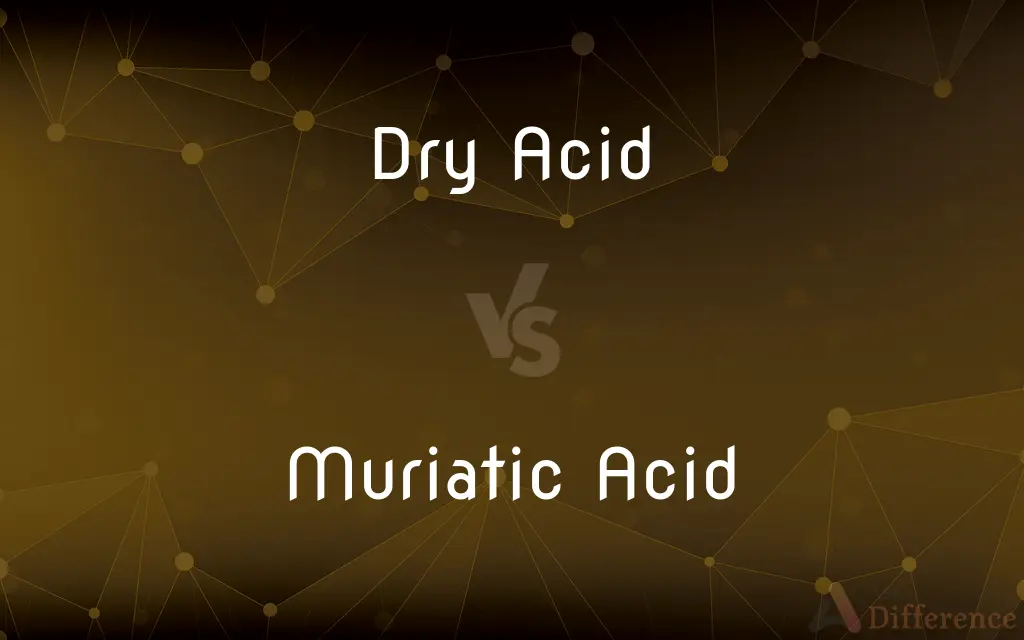Dry Acid vs. Muriatic Acid — What's the Difference?
By Tayyaba Rehman & Maham Liaqat — Published on October 6, 2024
Dry Acid, a granular form of bisulfate, is used to lower pH in pools without fumes, while Muriatic Acid, a liquid hydrochloric acid solution, acts more rapidly but requires careful handling due to its corrosive nature and fumes.

Difference Between Dry Acid and Muriatic Acid
Table of Contents
ADVERTISEMENT
Key Differences
Dry Acid, scientifically known as sodium bisulfate, is a granular substance used primarily to decrease the pH levels and alkalinity in swimming pools and spas. It's favored for its ease of storage and minimal risk of spills, making it safer for those without chemical handling experience. On the other hand, Muriatic Acid, a diluted form of hydrochloric acid, is also employed for similar purposes but is known for its aggressive action. It can quickly adjust water chemistry, making it a go-to for rapid corrections.
One of the key differences lies in their physical forms and the implications for handling and storage. Dry Acid's granular nature allows for straightforward measurement and dispensing, reducing the risk of accidental exposure. Muriatic Acid, being liquid, requires protective gear to prevent skin burns or respiratory issues from its fumes, necessitating more cautious handling and storage.
In terms of application, Dry Acid dissolves slowly in water, offering a more controlled and gradual pH adjustment. This property minimizes the risk of overshooting the desired pH level. Conversely, Muriatic Acid's rapid dissolving rate provides immediate results, beneficial for urgent adjustments, but with a higher risk of damaging pool surfaces if not properly diluted or dispersed.
Environmental and health safety concerns also differentiate these two chemicals. Dry Acid, while safer to handle, still necessitates proper disposal methods to prevent environmental harm. Muriatic Acid, with its potent fumes and corrosive nature, poses significant health risks, requiring stringent safety measures during use and disposal.
The choice between Dry Acid and Muriatic Acid depends on the specific needs of the pool maintenance task, balancing between ease of use, safety, and the urgency of water chemistry adjustments.
ADVERTISEMENT
Comparison Chart
Physical Form
Granular
Liquid
Handling Safety
Safer, minimal fumes
Corrosive, produces harmful fumes
Application Speed
Slow-acting, gradual adjustment
Fast-acting, immediate results
Storage Requirements
Easier, less risk of spills
Requires careful storage
Environmental Impact
Moderate, requires careful disposal
High, toxic fumes and corrosive
Compare with Definitions
Dry Acid
Slow-dissolving for gradual adjustment.
After adding Dry Acid, the pool's pH levels slowly returned to normal.
Muriatic Acid
Offers immediate water chemistry correction.
The pool's alkalinity levels were immediately lowered after Muriatic Acid application.
Dry Acid
Safer for inexperienced handlers.
Dry Acid is recommended for those unfamiliar with chemical pool maintenance.
Muriatic Acid
A diluted hydrochloric acid solution for rapid pH adjustment.
He used Muriatic Acid to quickly correct the pool's pH imbalance.
Dry Acid
Minimizes risk of accidental exposure.
Using Dry Acid reduces the risk of chemical burns during pool maintenance.
Muriatic Acid
Demands cautious storage.
Muriatic Acid bottles were stored upright in a ventilated area to prevent leaks and fume accumulation.
Dry Acid
A granular substance used to lower pH in pools.
To adjust the pool's pH, he added a measured amount of Dry Acid.
Muriatic Acid
Potentially harmful to the environment.
The disposal of Muriatic Acid must follow strict guidelines to avoid environmental damage.
Dry Acid
Requires careful disposal.
Despite its safer profile, disposing of Dry Acid must be done cautiously to protect the environment.
Muriatic Acid
Requires protective gear for handling.
When adding Muriatic Acid to the pool, wearing gloves and a mask is essential.
Common Curiosities
How should Dry Acid be stored?
Dry Acid should be kept in a cool, dry place, away from moisture and heat sources, in its original container.
Which acid is better for pool maintenance?
The choice depends on the situation; Dry Acid for safer, gradual adjustments, and Muriatic Acid for quick, significant changes.
Can Dry Acid be used instead of Muriatic Acid for all applications?
While both can adjust pH, their effectiveness and speed differ, making Muriatic Acid better for rapid adjustments.
What precautions are necessary when using Muriatic Acid?
Wear protective gear, ensure good ventilation, and carefully follow the manufacturer's instructions to avoid harm.
How do I dispose of unused Dry Acid or Muriatic Acid?
Consult local hazardous waste disposal guidelines, as improper disposal can harm the environment.
What is the main difference between Dry Acid and Muriatic Acid?
The main difference is their form and handling safety; Dry Acid is granular and safer to handle, while Muriatic Acid is liquid and more corrosive.
Can these acids affect pool equipment?
If not properly diluted or if spilled directly, both acids can corrode pool equipment and surfaces.
What should I do if I inhale fumes from Muriatic Acid?
Move to fresh air immediately and seek medical attention if symptoms persist.
Is Muriatic Acid safe for all pool types?
Muriatic Acid can be used in all pool types but must be carefully handled and correctly diluted to avoid damaging surfaces.
Can I mix Dry Acid with other pool chemicals?
Never mix chemicals directly; always dilute separately in pool water to prevent dangerous reactions.
Is it safe to swim immediately after adding these acids to the pool?
Wait until the chemicals have fully dispersed and pool chemistry levels return to normal before swimming.
Do Dry Acid and Muriatic Acid have the same environmental impact?
Muriatic Acid poses a higher risk due to its corrosive nature and toxic fumes, requiring more careful disposal.
How often should I use these acids in my pool maintenance routine?
Use as needed, based on regular testing of pool water chemistry and following the manufacturer's guidelines.
Can Muriatic Acid be neutralized before disposal?
Yes, it can be neutralized with a base, like soda ash, but this should be done following proper guidelines and safety procedures.
How do I measure the correct amount of Dry Acid for my pool?
Follow the manufacturer's instructions based on your pool volume and the current pH level.
Share Your Discovery

Previous Comparison
Ice Cream vs. Sherbet
Next Comparison
Bare vs. MinimalAuthor Spotlight
Written by
Tayyaba RehmanTayyaba Rehman is a distinguished writer, currently serving as a primary contributor to askdifference.com. As a researcher in semantics and etymology, Tayyaba's passion for the complexity of languages and their distinctions has found a perfect home on the platform. Tayyaba delves into the intricacies of language, distinguishing between commonly confused words and phrases, thereby providing clarity for readers worldwide.
Co-written by
Maham Liaqat












































